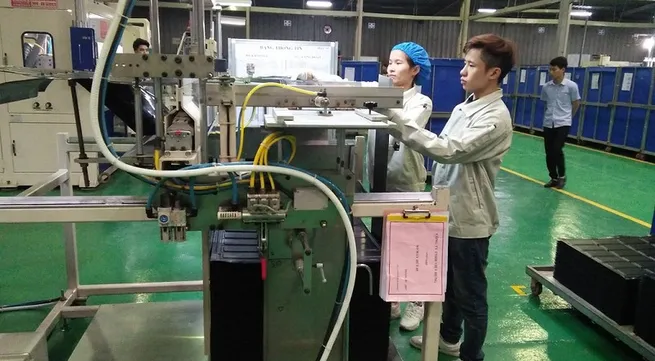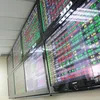Government orders continued solutions to back businesses

A rebound in industrial production is seen in the economy, with the government making efforts to woo more foreign direct investment
The government two days ago issued a resolution requesting the continued improvement of the local investment and business climate and of the economy’s competitiveness.
The government ordered that the Ministry of Planning and Investment host and push up the disbursement of public investment with ensured quality. Notably, this ministry has to “speed up the review and proposal of new measures to continue improving the domestic investment and business climate and ameliorate the economic competitiveness amid harsh competition to lure in foreign direct investment (FDI) in the region and the wider world.
Meanwhile the Ministry of Finance has been asked to effectively carry out policies regarding the extension of the payment time of and reduction of many types of taxes and fees, as well as land rental fees. It is also a must to accelerate the refunding of VAT for enterprises and people.
“The MoF must continue to research and propose more fiscal solutions to assist enterprises, and suggest the authorised agencies increase investment for infrastructure development in the coming years without causing any negative impacts on the country’s public debt safety and foreign debt, as well as the government’s debt,” stated Prime Minister Pham Minh Chinh, who signed and enacted the resolution.
On an uptrend
The government’s new move comes amid an uptrend of domestic industrial production and confidence of the business community bouncing back.
Fresh figures announced a few days ago by the Ministry of Industry and Trade show that the index of industrial production (IIP) is continuing to expand month-on-month since early this year. In June alone, the IIP is estimated to have climbed 2.8% as compared to the same period last year.
“Cumulatively in the first six months of this year, industrial production has recovered 98.8% over the corresponding period last year,” the MoIT stated in a report. “The processing and manufacturing industry’s added value in this period increased 0.37% (down 0.49% in the first quarter but bouncing back to a rise of 1.18%), creating a total added value of 0.1% for the whole economy.”
The six-month IIP of a number of key industries has recorded a year-on-year high increase, including coke and refined petroleum (13.2%); metal ore exploitation (11.5%); rubber and plastic product production (7.2%); tobacco production (6.7%); drinks production (5.7%); and the exploitation, treatment, and supply of water (5.6%).
The MoIT reported that in June, total electricity output domestically produced and imported onto the national power system is estimated to have reached 25.323 billion kWh, up 3.4% year-on-year. In the first half of this year, the figure hit 136,090 billion kWh – including rooftop solar power joining the system, up 2.2% year-on-year and reaching 47.8% of the initial plan of 284.5 billion kWh for the entire year.
Meanwhile, the oil and gas industry reported that in the first half of this year, it, with PetroVietnam acting as the key player, recorded relatively good performance results.
Specifically, its total exploited oil and gas volume is estimated to sit at 9.48 million tonne of oil equivalents, exceeding by 20% the six-month plan and tantamount to 62% of the whole year’s plan.
Of which, the six-month exploited oil volume is estimated to stand at 5.31 million tonnes – surpassing by 14% the six-month plan and equal to 57% of the entire year’s plan. Of which, domestically-exploited crude oil volume is estimated to be 4.41 million tonnes, equivalent to 59% of the whole year’s plan, while exploited gas volume is estimated to have hit 4.17 billion cubic metres, tantamount to 70% of the entire year’s plan.
Also in the first half of this year, 48 out of 63 cities and provinces nationwide witnessed a climb in their IIP thanks to expansion in the processing and manufacturing industry and in the electricity production and distribution industry, such as Bac Giang (16.2%); Phu Tho (15.3); Kien Giang (13.6%); Nam Dinh (13.4%); both Haiphong and Phu Yen (13%); Ha Nam (11.7%).
A number of localities with a high IIP in electricity production and distribution include Hau Giang (264.4%); Thai Binh (70.4%); Tra Vinh (29.4%); and Nam Dinh (11.9%).
Some major industrial hubs of Vietnam have recovered their industrial production growth such as Thai Nguyen (4.1%); Quang Ninh (7.4%); Bac Giang (15.7%); Haiphong (12.3%); Ho Chi Minh City (1.9%); Binh Duong (2.6%); and Dong Nai (3%).
After growing 3.32% in the first quarter of this year, the Vietnamese economy bounced back to 4.14% in the second quarter. In the first half of the year, it rose 3.72% year-on-year.
The Ministry of Planning and Investment (MPI) last week reported to the government two fresh economic growth scenarios for the second half of this year and the entire year, based on the low growth rate for the first half of 2023.
Under the first scenario, the economy will likely grow 6% this year, 6.8% for the third quarter and 9% for the fourth quarter, 0.3% and 1.9% respectively higher than the initial plan set out earlier this year. The rate must be 8% in the second half of the year.
Under the second scenario, the whole-year growth rate is set to be 6.5%, with 7.4% for the third quarter and 10.3% for the fourth quarter, 0.9% and 3.2% respectively higher than the initial plan set earlier this year. The rate must be 8.9% in the second half of the year.
“However, we will have to make all our best efforts to materialise the set target of 6.5% despite the massive difficulties ahead. We must take advantage of all opportunities and policies, and overcome challenges to accomplish the growth goal,” said MPI Minister Nguyen Chi Dung.
Wooing more FDI
Amid the difficulties which remain in Vietnam, the government has been making efforts to lure in FDI, turning Vietnam into an attractive investment destination.
The MPI reported that in spite of a 4.3% decrease in the volume of FDI inflows into Vietnam in the first six months of 2023, there are positive signals when looking into the structure of the investment.
Out of over 13.43 billion USD worth of foreign investment poured into Vietnam in the first half of this year, newly-registered capital hit almost 6.5 billion USD, responsible for 48.3% of the total, up 31.3% year-on-year.
The value of capital contributions and share purchase deals soared 79% to more than 4 billion USD, accounting for 29.9% of the total.
Only additional capital for existing projects showed a reduction of 57.1%, but the number of projects increasing their capital expanded 29.8%.
“Despite difficulties, FDI is still positive in Vietnam. Many large-scale projects, including some worth billions of USD from the Republic of Korea are waiting to enter Vietnam,” said Do Nhat Hoang, general director of the Foreign Investment Agency under the MPI. “For example, Haiphong authorities on June 26 handed over a licence to LG Innotek Vietnam Hai Phong Co., Ltd. to add more than 1 billion USD to its project in the city, increasing its total investment to over 2.05 billion USD.”
The European Chamber of Commerce in Vietnam, the voice of the European business community in Vietnam, on July 10 released the results of its highly anticipated Business Confidence Index (BCI) for the second quarter of 2023. Conducted by Decision Lab, the BCI reveals a modest decline of 4.5 points in European business confidence towards the Vietnamese market, with the current score of 43.5 reflecting prevailing market conditions.
The BCI reveals a challenging outlook, with a significant 10% increase in negative responses regarding the current business situation. This growing sense of caution is further reflected in a 6% rise in negative sentiment regarding the upcoming quarter.
However, amidst the challenges, there is also a glimmer of encouraging news. The report shows a 9% increase in the number of business leaders who assess their business prospects positively for the third quarter of 2023 compared to their assessment for the second quarter of 2023.





